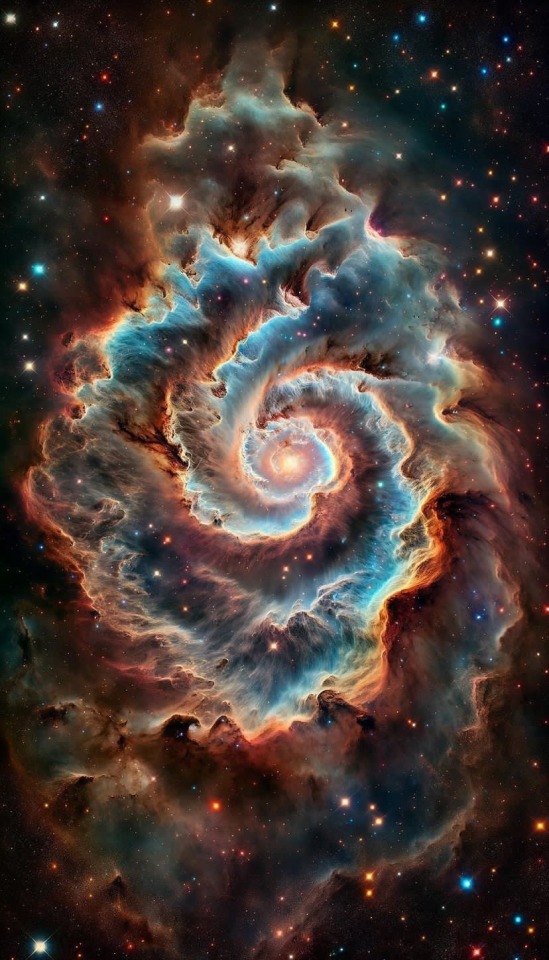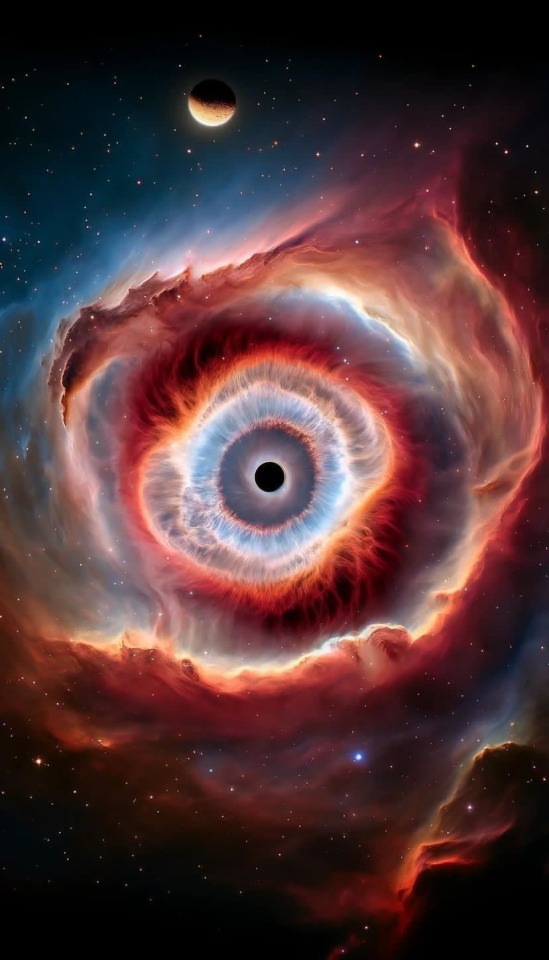We Have Tons More Of These Beautiful Images Coming!!!







We have tons more of these beautiful images coming!!!
More Posts from Dukeofwatts and Others

This winter snow angel is out of this world! The Hubble Space Telescope captured this festive image of the bipolar star-forming region Sharpless 2-106. A massive, young star, IRS 4 is responsible for the furious star birth we see in this nebula. Twin lobes of super-hot gas, glowing blue in this image, stretch outward from the central star. This hot gas creates the “wings” of the celestial angel.
A ring of dust and gas orbiting the star acts like a belt, cinching the expanding nebula into an hourglass shape. Hubble's sharp resolution reveals ripples and ridges in the gas as it interacts with the cooler interstellar medium.
Credit: NASA, ESA, and the Hubble Heritage Team (STScI/AURA).
ALT TEXT: Looking somewhat like an angel with outstretched wings, this blue-and-orange star-forming region is set against a black background punctuated by bright stars of various sizes. Some of the stars are white, while others are orange, and one in the bottom-right corner is bright red. Many of these stars have starburst-like diffraction spikes. The “angel’s” long wings are cavities outlined in a feathery pattern of blue and white. Its flowing, “dress” is a triangular, orange area of denser, dustier gas that trails off into the blackness of space. At its waist is a bright white-and-orange, centrally located star.

Birds of a Feather by Hubble Space Telescope / ESA

Hubble Celebrates its 33rd Anniversary With NGC 1333 in Perseus

M51, Whirpool Galaxy

Arp 87, Galaxy Dance


NASA’s new images of Uranus captured by James Webb Space Telescope (2024)

Large Magellanic Fireworks by NASA's Marshall Space Flight Center

Setting Sail to Travel Through Space: 5 Things to Know about our New Mission
Our Advanced Composite Solar Sail System will launch aboard Rocket Lab’s Electron rocket from the company’s Launch Complex 1 in Māhia, New Zealand no earlier than April 23, at 6 p.m. EDT. This mission will demonstrate the use of innovative materials and structures to deploy a next-generation solar sail from a CubeSat in low Earth orbit.
Here are five things to know about this upcoming mission:
1. Sailing on Sunshine
Solar sails use the pressure of sunlight for propulsion much like sailboats harness the wind, eliminating the need for rocket fuel after the spacecraft has launched. If all goes according to plan, this technology demonstration will help us test how the solar sail shape and design work in different orbits.

2. Small Package, Big Impact
The Advanced Composite Solar Sail System spacecraft is a CubeSat the size of a microwave, but when the package inside is fully unfurled, it will measure about 860 square feet (80 square meters) which is about the size of six parking spots. Once fully deployed, it will be the biggest, functional solar sail system – capable of controlled propulsion maneuvers – to be tested in space.

3. Second NASA Solar Sail in Space
If successful, the Advanced Composite Solar Sail System will be the second NASA solar sail to deploy in space, and not only will it be much larger, but this system will also test navigation capabilities to change the spacecraft’s orbit. This will help us gather data for future missions with even larger sails.

4. BOOM: Stronger, Lighter Booms
Just like a sailboat mast supports its cloth sails, a solar sail has support beams called booms that provide structure. The Advanced Composite Solar Sail System mission’s primary objective is to deploy a new type of boom. These booms are made from flexible polymer and carbon fiber materials that are stiffer and 75% lighter than previous boom designs. They can also be flattened and rolled like a tape measure. Two booms spanning the diagonal of the square (23 feet or about 7 meters in length) could be rolled up and fit into the palm of your hand!

5. It’s a bird...it’s a plane...it’s our solar sail!
About one to two months after launch, the Advanced Composite Solar Sail System spacecraft will deploy its booms and unfurl its solar sail. Because of its large size and reflective material, the spacecraft may be visible from Earth with the naked eye if the lighting conditions and orientation are just right!
To learn more about this mission that will inform future space travel and expand our understanding of our Sun and solar system, visit https://www.nasa.gov/mission/acs3/.
Make sure to follow us on Tumblr for your regular dose of space!

Hubble Spotlights a Swirling Spiral by NASA Hubble






Damn what a beautiful universe we have
-
 dongjawnsilver liked this · 3 months ago
dongjawnsilver liked this · 3 months ago -
 l1v32d13-d132l1v3 reblogged this · 3 months ago
l1v32d13-d132l1v3 reblogged this · 3 months ago -
 hc1701 reblogged this · 3 months ago
hc1701 reblogged this · 3 months ago -
 hc1701 liked this · 3 months ago
hc1701 liked this · 3 months ago -
 deadmandet13 reblogged this · 3 months ago
deadmandet13 reblogged this · 3 months ago -
 deadmandet13 liked this · 3 months ago
deadmandet13 liked this · 3 months ago -
 covertrook liked this · 3 months ago
covertrook liked this · 3 months ago -
 pipuisci reblogged this · 3 months ago
pipuisci reblogged this · 3 months ago -
 pipius liked this · 3 months ago
pipius liked this · 3 months ago -
 k-llewellin-novelist reblogged this · 3 months ago
k-llewellin-novelist reblogged this · 3 months ago -
 sereiaserendipia liked this · 3 months ago
sereiaserendipia liked this · 3 months ago -
 addicted-to-nothing liked this · 3 months ago
addicted-to-nothing liked this · 3 months ago -
 nooran13jm liked this · 4 months ago
nooran13jm liked this · 4 months ago -
 ringingurline liked this · 4 months ago
ringingurline liked this · 4 months ago -
 purest-of-trash liked this · 6 months ago
purest-of-trash liked this · 6 months ago -
 paula-11 liked this · 8 months ago
paula-11 liked this · 8 months ago -
 tassianamilka liked this · 8 months ago
tassianamilka liked this · 8 months ago -
 frenchfan liked this · 8 months ago
frenchfan liked this · 8 months ago -
 lanternofbutterflies liked this · 8 months ago
lanternofbutterflies liked this · 8 months ago -
 shaveurasshole reblogged this · 9 months ago
shaveurasshole reblogged this · 9 months ago -
 alieba liked this · 9 months ago
alieba liked this · 9 months ago -
 werewolf240moon liked this · 9 months ago
werewolf240moon liked this · 9 months ago -
 timelessanimo liked this · 9 months ago
timelessanimo liked this · 9 months ago -
 froml-withlove reblogged this · 9 months ago
froml-withlove reblogged this · 9 months ago -
 froml-withlove liked this · 9 months ago
froml-withlove liked this · 9 months ago -
 light-yagami-l liked this · 9 months ago
light-yagami-l liked this · 9 months ago -
 isthis-a-crossoverepisode liked this · 9 months ago
isthis-a-crossoverepisode liked this · 9 months ago -
 zia-fox liked this · 9 months ago
zia-fox liked this · 9 months ago -
 starynighty reblogged this · 9 months ago
starynighty reblogged this · 9 months ago -
 starynighty liked this · 9 months ago
starynighty liked this · 9 months ago -
 c0smicdrift3r reblogged this · 9 months ago
c0smicdrift3r reblogged this · 9 months ago -
 artoftcbaldwin liked this · 9 months ago
artoftcbaldwin liked this · 9 months ago -
 misty-missdee reblogged this · 9 months ago
misty-missdee reblogged this · 9 months ago -
 vegeta-sama-13 liked this · 9 months ago
vegeta-sama-13 liked this · 9 months ago -
 ghostlyninjadefendor reblogged this · 9 months ago
ghostlyninjadefendor reblogged this · 9 months ago -
 discopunkt reblogged this · 9 months ago
discopunkt reblogged this · 9 months ago -
 owlzowlz reblogged this · 9 months ago
owlzowlz reblogged this · 9 months ago -
 pandawallls liked this · 9 months ago
pandawallls liked this · 9 months ago -
 braunbaer liked this · 9 months ago
braunbaer liked this · 9 months ago -
 the-floppa-k1ller liked this · 9 months ago
the-floppa-k1ller liked this · 9 months ago -
 vielvergnugen liked this · 9 months ago
vielvergnugen liked this · 9 months ago -
 zack1997me reblogged this · 9 months ago
zack1997me reblogged this · 9 months ago -
 awsomequadrunner liked this · 9 months ago
awsomequadrunner liked this · 9 months ago -
 little-creecher liked this · 9 months ago
little-creecher liked this · 9 months ago